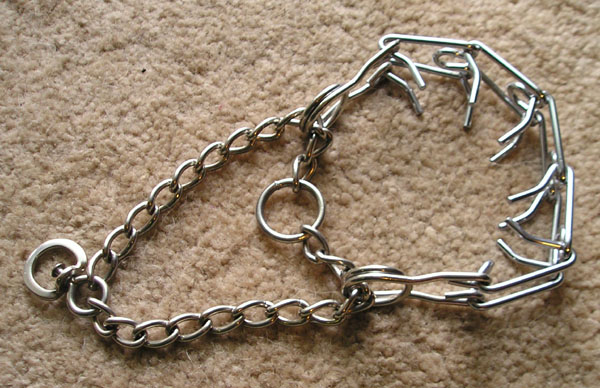
This post may contain affiliate links. We are compensated for referring customers to our affiliate partners.
Prong collar training is a tried and proven method to quickly and efficiently train almost any dog, large or small. In many countries, they are actually called training collars. In recent years, however, the use of prong collars has come under quite a bit of scrutiny. Many believe prong collars are cruel and even injure a dog. The truth is, a properly fit prong collar is perfectly safe for a dog when used correctly by the trainer (that’s you!). It does not, and should not, inflict severe pain or choke the dog in any way. In fact, prong collars are specifically designed to do the opposite. A prong collar looks pretty intimidating, there’s no doubt about that. They can even look downright painful. But looks can be deceiving.
Are Prong Collars Humane?
Ok, before we really get into this, let’s address the elephant in the room. Many dog owners are told that prong collars are inhumane and should never be used under any circumstances. There is a whole lot of misinformation out there claiming that prong collars cause a great deal of pain and can even cause physical harm to your dog. All of this is true, but only if the prong collar is misused!
I’m going to write the next part in bold because it’s really important. Prong collars are not inhumane – people who use them improperly are! It’s true, prong collars are the most abused training tool around. Even so-called professional trainers abuse them quite often. Further down this page, I’m going to explain how a prong collar can be effectively used, without causing undo pain to your dog and without risking any injury at all. Not only will you understand how a prong collar can be used in a completely humane and pain-free way, you’ll also learn that prong collar training isn’t as terrible, dangerous, or painful as many will lead you to believe. If you’re doing it right, your dog will actually have fun and get excited anytime you put the collar on.
If your #1 concern about prong collar training is a fear of hurting your dog or harming the relationship and bond you have with your dog, I urge you to keep reading. There’s a lot to learn here, but stick with me! This is some important stuff which will help you communicate effectively with your dog. When you’re able to communicate effectively with your dog, everyone wins.
A Special Note About Aggressive Dogs
You should never, ever use a prong collar on an aggressive dog unless you’re getting professional assistance from a very reputable trainer. A prong collar can make a dog even more aggressive when improperly used. Since aggressive dogs need a highly customized training program, they are beyond the scope this website can cover. But please, do not use a prong collar as a means to reduce aggression. Using a prong collar on an aggressive dog can lead to some very dangerous situations and may make the problem worse. No website can help with an aggressive dog. You need personalized attention (the sooner the better).
How A Prong Collar Works
Let’s start with the basics. One of the first things we learn in drivers ed is keeping control in a safe manner. The same holds true with prong collars. In order to use prong collar training safely and effectively, it’s important to first know how prong collars work and how they are designed. A prong collar has a very specific design and when used correctly, it will be effective on almost any type of dog. Why is it so effective? Because the collar is designed to mimic the sensation of when a mother bites it’s pup. You can see evidence of that type of behavior in the below video where a mother Shih Tzu corrects her two young pups when their playing crosses the line.
Mother Corrects Her Pups By Biting Their Necks
As you can see, from a very young age, puppies learn when they’ve done something unacceptable when their mother physically bites their necks, most commonly the back of the neck. You could hear those puppies cry out a little bit, although no physical harm is being inflicted by the mother. Luckily, as humans, we can control the amount of force used and can cause even less discomfort than the mother caused in the above video. As a general rule of thumb, the least amount of force required to get a result is the most amount of force which should ever be used. If you need to use more than a couple fingers on the leash while using a prong collar, you’re doing something wrong. When a prong collar is properly used, there is very little discomfort involved.
By far, the most common misuse of a prong collar is improper fitting of the collar. A prong collar is specially designed so as to not cause physical harm or inflict pain. Unlike a choke chain or choke collar, a prong collar is designed to create an equal amount of pressure all the way around the dogs neck. Think of it like a person lying down on a bed of nails. No physical harm is done because of equal distribution. Further, a prong collar is designed so that it will only close a maximum of about 2 inches to a maximum of 4 inches (you choose how much it closes – we’ll get to that in a minute). By comparison, a choke chain causes an enormous amount of pressure on the front of the neck and will also close as far as your dogs throat and esophagus will allow. Not good! You wouldn’t guess by looking at the photos below, but the choke chain on the left is far more likely to cause your dog physical harm and pain. Again, a properly used prong collar will not choke or harm your dog!
Choke Chain (left) & Prong Collar (right)
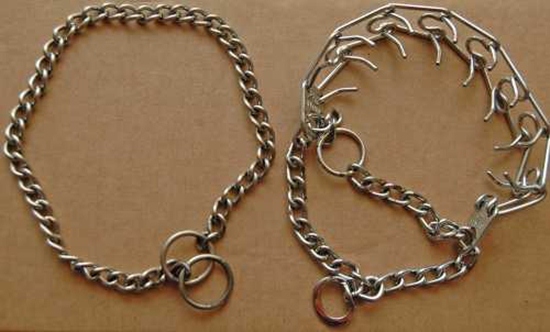
Finding The Right Fit
The biggest mistake made by those who are unfamiliar with a prong collar is having the collar too loose. In order for the collar to work properly, it must be very snug. If it isn’t, you’ll create a pressure point at the front of the dogs neck – their most vulnerable area! By keeping it firm, the prong collar can tighten evenly around the entire dogs neck, greatly reducing the risk of injury or discomfort to your dog. Always remember, a properly fitted prong collar should not be able to slip over your dogs head. You must connect it and disconnect it each time you put on or take off the collar. If you can slip the prong collar over your dogs head and onto his or her neck, it’s way too loose and you are causing your dog harm!!
I can’t stress enough how important it is to properly fit and secure a prong collar. When used incorrectly, you will cause your dog an unnecessary amount of discomfort and you will cause internal injuries to your dogs esophagus. Many people are uncomfortable keeping the collar tight on their dog and feel like a loose collar is more humane. It’s not! People who do this are unknowingly causing their dog unnecessary pain and it could result in serious injuries to your dog. While prong collar training is extremely effective with nearly any dog of any breed, they are also the most dangerous collars on the market when misused. Unfortunately, they are misused a lot. Please watch the below video for a better idea on how to properly fit a prong collar on your dog.
How To Properly Fit A Prong Collar
If you decide to use a prong collar, you need to understand that it will come loose at some point. It’s not a matter of if, it’s a matter of when. You’ll want to have your dog wear another collar which is loose enough as to not restrict the prong collar, but tight enough so that if the prong collar does come loose, you’ll still have control over your dog. This is one major drawback to a prong collar and is especially true with quick release prong collars. I know the above video mentioned quick release collars, but I do not recommend you use one. If you use a prong collar, just get a regular one without a quick release.
How To Train Your Dog With A Prong Collar
Alright, now we’re getting somewhere! Now that you understand how a prong collar works and how to properly fit the prong collar on your dog, we can begin to learn how to use prong collar training without causing pain or risking physical harm. You’ll learn how to use the prong collar gently and you’ll also learn how to communicate very effectively in a way your dog can easily understand. It’s a fair system for everyone and will allow you to do things with your dog you never thought possible, eventually without having to use a prong collar anymore! You can and you will have that dog everyone is envious about. Exciting stuff, right?! You’re about to take back control and you’ll do it safely and effectively. So let’s get started! Continue onto page two by clicking the link below.
Here are the 5 main steps to training your dog with a prong collar. Remember, a prong collar is only abusive if you make it that way. When used properly, it can be a very humane and highly effective training device.
Step One: The Introduction
This is the single most important step when training a dog with a prong collar. Many people make the mistake of putting the prong collar on and going to work right away. By moving too quickly, you’ll confuse the frighten your dog. Dog need to learn that a prong collar is nothing to fear. In fact, after just a few days, your dog will get excited any time you bring the prong collar out and will sit patiently with a wagging tail as you put it on.
The first thing you’ll want are some super awesome and tasty treats. I prefer to grill some chicken breasts and cut them into really small pieces. Dogs tend to love plain ol’ chicken breasts and they’re healthy, too. The largest size of chicken you’ll want is the size of a US dime. With most dogs, especially dogs which are very food motivated, a little piece the size of a pea will do it. Any type of steak is also a healthy yet effective treat. We need this to be an awesome experience for your dog so don’t cheap out on the treats here.
Ok, now grab your treats and take your dog somewhere he or she is comfortable. Show the prong collar to your dog. If you just bought the prong collar and haven’t used it yet, the collar will be too large. That’s ok, we’ll take care of that later. All we’re doing right now is showing your dog the prong collar. The moment your dog looks at the collar or pays any attention to it, say something really happy and upbeat. I like to say, “YES!” At the exact same time you say “YES!”, give your dog a little treat followed by some love and praise. When your dog looks at the collar again, once again say, “YES!” and give your dog another treat! Hopefully, your dog takes it further and touches the collar with his or her nose or paws at it. Once again, say “YES!” and give your dog a treat! Keep doing this until you see that your dog is putting the pieces of the puzzle together. Once your dog has associated the prong collar with happiness, treats, love, and praise, we’re ready to move onto the next step.
Step Two: Putting The Prong Collar On Your Dog
Your dog already likes the prong collar, so this should be pretty easy. If your dog is still afraid or unsure of the collar, you need to go back to step one and repeat that step as many times as necessary with as many breaks as necessary. Be patient. Before we can start using a prong collar effectively, your dog must be comfortable with it.
Alright, now it’s time to put the collar on your dog. Take the collar out and once again, show your dog the collar. Now, let’s take it a step further. Place the collar around your dogs neck and link it together. If you just purchased the collar, it should be pretty loose. That’s ok for now, we’ll take care of that. If the collar is snug, that’s fine too as long as your dog isn’t showing any signs of pain. Many dogs will scratch at or try to “shake off” the collar, but this behavior usually subsides after the first few lessons. As long as your dog seems comfortable and free from pain, practice taking the collar off and putting it back on, treating and rewarding your dog during each step of the process.
Step Three: Custom Fit The Prong Collar
Now that your dog has associated the prong collar with happiness and is also comfortable having it placed around his or her neck, it’s time to get the right fit. You should have watched the video on page one about properly fitting a prong collar. If not, I recommend you go back and watch it now.
What you’ll want to do is remove some of the prongs until it has a snug fit. The prong collar should fit snugly around your dogs neck, just behind the ears and jawline – up high on the neck. I personally prefer to have the “chain” part of the collar around the front of the neck. Even if you have the prongs of the collar around the dogs throat, it shouldn’t cause any physical harm to your dog since the prong collar is designed to have a limited slip. Here are a couple images to help show a proper vs improper fit.
Proper Fit (left) & Improper Fit (right)
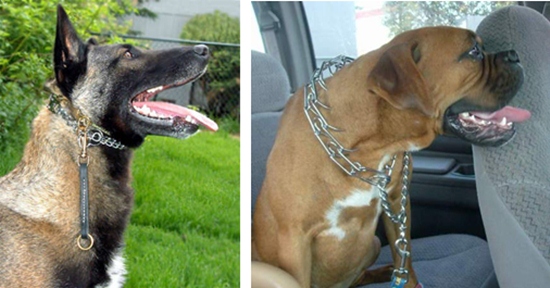
In addition to fitting the collar correctly, you must know when it’s appropriate to use the prong collar or not. You don’t want the dog to act one way when the collar is on and another way when the collar is off. Many times, a dog will behave perfectly while wearing a prong collar, but once the prong collar comes off, the dog goes right back to behaving poorly. That’s because the dog hasn’t been desensitized to the collar. When using a prong collar for training, it’s important to desensitize your dog.
How do you desensitize a dog to a prong collar? You simply put the collar on and take it off randomly throughout the day. After a while, the collar has no meaning to the dog. If your dog still shows some fear or anxiety towards the collar, you can try to associate putting the collar on with desirable activities such as before feeding breakfast or dinner. The goal here is to get your dog to forget about the collar entirely. That way, when there is a correction, your dog knows the correction is coming from you and not the collar, per say. This can be achieved through desensitization, as explained above.
I know, we just spent all that time getting the dog to associate the collar with fun and excitement! That was only necessary during the first step so your dog could be slowly introduced to the collar and not become afraid of it. Now that we know your dog isn’t fearful of the collar, the next step is the desensitize your dog to the collar.
You’ll want to put the prong collar on your dog at least 20 minutes before using it for training. Likewise, you’ll want to wait 20 minutes after using a prong collar before taking it off. You don’t want your dog to associate the collar with any particular event. If your dog gets really excited when you bring the prong collar out, you need to do some more desensitizing.
Step Four: Teaching The Rules
At this point, your dog is comfortable wearing the collar, you have the collar properly sized for your dog, you only use the collar during appropriate times, and you’ve desensitized your dog to the prong collar. Things are going great! Time to put the collar to use!
When using a prong collar, your dog must understand that corrections are caused because of the actions he or she takes. You don’t want a dog who feels powerless or confused by a correction. You want a dog who feels confident and has a clear understanding of what the leader (that’s you!) expects. The key here is to communicate with your dog, not punish your dog. You want a dog who feels in control of whether praise or discomfort occurs. When the rules are clearly laid out and the dog understands what causes a correction, how to avoid a correction, and how to discontinue corrections, you can start to easily communicate in a way your dog will quickly and easily understand. Not only will your dog be able to understand what a correction means, but your dog will understand how to prevent a correction in the first place. That means, in a very short period of time, you won’t have to correct your dog at all and eventually, the prong collar can be phased out completely. Using a prong collar is not a lifelong collar for a dog. It is used for training and communicating basic rules. Once your dog has a full understanding of the rules, the prong collar is no longer needed.
It’s a bit easier to show you how to begin using a prong collar rather than try to explain it in writing. The below video is an excellent intro into how to first begin using a prong collar. Make a special note of the little dog at the beginning of the video with his tail between his legs. After using a prong collar for just a short period of time, the dog begins to gain confidence, comes out of his little shell, and becomes much more comfortable. When the rules are clear cut and the dog understands the rules, it reduces a lot of stress from the dog. Also notice the very small amount of pressure being used and the praise given to the dogs. You must use lots and lots of praise in conjunction with a prong collar.
First Lessons Using A Prong Collar
Once your dog understands how the prong collar works, you’ll see just how quickly your dogs behavior and leash manners improve. Using a prong collar is fun during this step because you can witness your dogs progress in just a matter of minutes. You now have full control over your dog and soon, you’ll be walking around without a leash at all. Your dog will become more and more a part of your everyday life and will enjoy doing things most dog owners would never feel comfortable with. You will be able to grow a stronger bond with your dog, communicate more effectively with your dog, and enjoy more places together. By taking the time to effectively communicate and explain the rules, both you and your dog can get more enjoyment out of life. Remember, you are the leader and your dog will look to you as such. Be confident, be fair, and be clear in your communication through lots of repetition. Your dog will test you from time to time. Pack leaders in wild dog packs are constantly being tested. The pack wants to make sure the leader isn’t getting weak. Your dog will test you in the same way. Make sure you remain a consistent leader by reliably and predictably enforcing the same rules.
The Benefits Of Using A Prong Collar
What is the ultimate goal you have for your dog? You want your dog to enjoy life as much as possible, right? In order for your dog to truly enjoy life to the fullest extent, you need to be the leader and set some ground rules. It doesn’t take long and the end result of you gaining control over your dog is that your dog will gain more freedom. When you and your dog trust each other, you can take your dog anyplace at anytime without stress or anxiety. You’ll be able to go on long walks without a leash and you won’t have to worry about your dog becoming reactive or over excited. You can have your dog run around off-leash at a park and not worry about your dog running after people, dogs, cars, or anything other than the tennis ball you brought. You can take your dog to crowded places and everyone will tell you how well behaved your dog is. Your dog will enjoy more out of life because there are set ground rules and your dog will know what the limits are. I can’t think of a faster way to achieve this goal than by using a prong collar combined with some positive reinforcement training such as clicker training. A prong collar is only a temporary device and should always be used in conjunction with positive reinforcement techniques.
While prong collars are often looked down upon as being inhumane, let’s flip that arguement. Some of the alternatives to using a prong collar can actually be less humane. Let’s explore the most common types of collars.
Flat Collar
A flat collar is a regular collar made of fabric or leather. These are awful to use with a leash because typically, the dog will pull against the collar. A flat collar is not designed to disperse the force around the neck and therefor, a dangerous pressure point is created right on the dogs esophagus. Not good! This can choke the dog and cut off air supply and you could actually be causing internal damage. To make matters even worse, your dog isn’t learning anything. You actually get the opposite effect as your dog will try to “run away” from the thing that is choking him or her (this is a natural reaction in dogs). Obviously this only makes the situation worsen and the problem will only continue. If your dog pulls on the leash, using a flat collar is not very humane!
Martingale Collars
Martingale collars are the same as flat collars, but they are designed to tighten as the dog pulls. These collars do a slightly better job of dispersing the pressure, but they still cause a pressure point at the dogs throat and causes the dog to pull even harder. As with a flat collar, dogs learn nothing from using these and will continue to pull and choke. If your dog pulls on the leash, a martingale collar is not very humane!
Gentle Leader Collar
A gentle leader collar is designed to go around the dogs head and snout. This allows you to physically turn your dogs head. Now, imagine for a second what it would feel like to have your head forced around. Generally, dogs don’t perceive any “correction” from this sort of collar and therefore, remains confused as to why they lose control of their own bodily movements. It’s true, these collars are a very popular alternative to prong collars and they can be used very effectively. But they also pose the same risk of abuse and potential injury. These collars or no more or less humane than a prong collar, they are simply a different type of tool.
Choke Collars
A choke collar is probably the worst type of collar you could ever put on a dog. This type of collar can cause serious harm to your dog. The reasoning should be obvious. Please, do not ever use a choke collar. If you are using a trainer who recommends a choke collar or choke chain, find another trainer! Choke chains are outdated and no longer used by most trainers.
Training Harness
Many harnesses, especially those which you clip the leash onto the dogs back, actually facilitate pulling. A harness is designed to go around the strongest part of a dogs body and can actually trigger the dogs natural instinct to pull. The longer you use that harness, the more your dog is reinforced to pull. Other harnesses are designed to have a leash clipped onto the front, at the chest of your dog. These are usually marketed as “no pull” harnesses. These are much better than using something like a flat collar, but will do almost nothing to actually stop excessive pulling or reactivity towards other dogs or people. Since there is no precise correction, your dog will remain confused and will learn nothing.
Prong Collars Aren’t For All Types Of Training
Prong collars are a great tool, but they should be used in conjunction with positive reinforcement training techniques. I am a huge fan of clicker training, for example. With clicker training, you can teach your dog almost anything. You also need to constantly assert yourself as the pack leader. If your dog doesn’t see you as a true leader, your dog will feel anxious and stressed. That will show in your dogs behavior and make you stressed, too!
Many people claim using a prong collar is not necessary and all you need is positive reinforcement like clicker training. That may be ok for some dogs, but most dogs will benefit greatly from prong collar training. While clicker training is a great way to train in some circumstances, it just won’t work in others. A true leader doesn’t wait for the right decision to be made. A true leader will lead by laying ground rules and taking control of the situation. This doesn’t have to be done in a cruel way. A prong collar is simply a fast track so your dog can enjoy life to the fullest. When used in conjunction with positive reinforcement training techniques, using a prong collar can be fun and the bond you form with your dog will be spectacular.
Final Statement On Using A Prong Collar
When using a prong collar correctly, you and your dog have nothing to lose and everything to gain. It’s safe, it’s effective, it will allow you and your dog to enjoy life more, and when used in conjunction with positive reinforcement techniques, training will be a fun experience which will strengthen the bond you have with your dog.
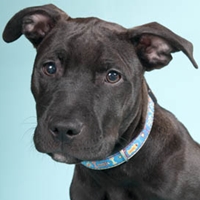
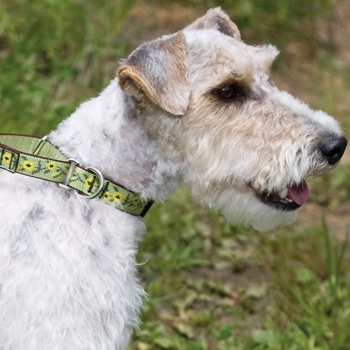
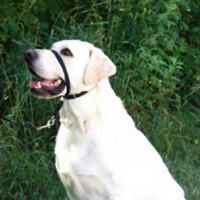



Hello, a very helpful article and helpful videos. I have used prong collars on my last two dogs with great success. I now have an almost 6 month old puppy and would like to train with a prong collar. At what age should my puppy be to start training? My other dogs were all older when I brought them into our home. Many thanks,
C.
I have stared my almost 6 mos old youngster in her prong. I have used them on very many of my past dogs at about the same age, but it depended on the dog. She was showing early stages of wanting to be in control, and walks were starting to be not pleasant. She is a quick study, and learned very fast how to control not getting corrected. Walks again are great fun. I personally wouldn’t wait to start till problems developed.
Hi,
Do I need to be concerned about how “heavy duty” the prongs are? I purchased one today, and I am physically unable to squeeze the prongs to remove links. Any advice? I have looked a food deal online and cannot find anything about prong thickness. My dog is a 55-60 lb. Lab pointer mix. He’s VERY strong.
Thanks!
I have a Bernedoodle with a LOT of fur. How can I be sure that the fit is right with all that fur? Thank you!